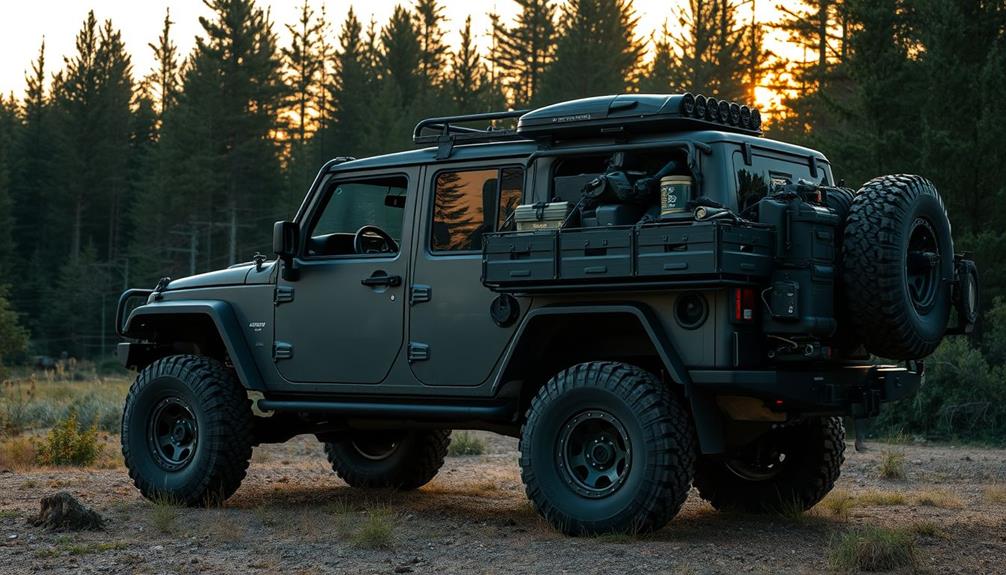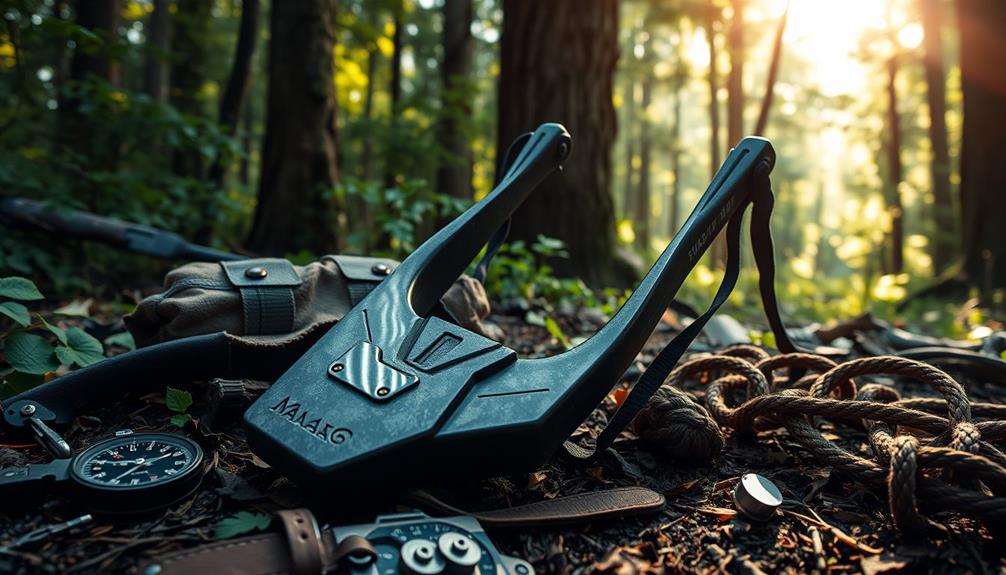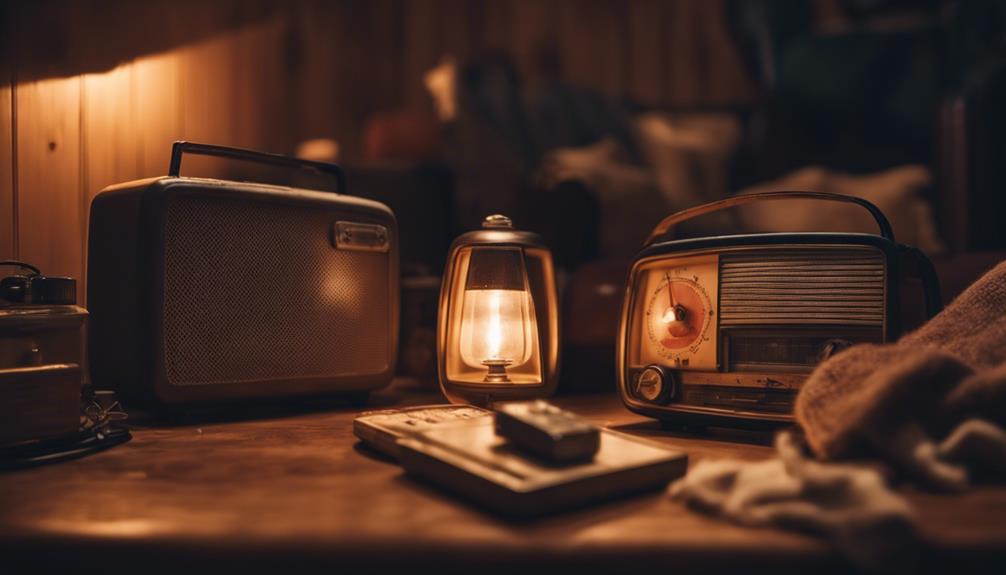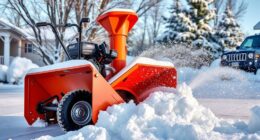To gear up your bug out vehicle today, start by ensuring it's reliable for rough terrain. Perform regular maintenance checks on oil, brakes, and tires. Equip it with durable storage solutions for organizing supplies. Don't forget non-perishable food, a first aid kit, and essential fire safety gear. Include a portable generator for power outages, plus communication tools like satellite phones or two-way radios. Finally, keep navigation resources handy, such as up-to-date maps and a reliable compass. With these essentials in place, you'll feel more confident and prepared for any emergency that arises. You'll be surprised by what else you might need!
Key Takeaways
- Ensure your vehicle is reliable and regularly maintained for optimal performance in rough terrain.
- Pack essential emergency supplies, including non-perishable foods and a comprehensive first aid kit.
- Equip your vehicle with durable water storage solutions and purification methods for safe drinking water.
- Include effective communication tools like satellite phones and two-way radios to stay connected during emergencies.
- Carry personal protection equipment and fire safety gear to enhance safety and preparedness on your journey.
Bug Out Vehicle Essentials

When preparing for emergencies, your bug out vehicle isn't just a mode of transportation—it's an essential part of your survival strategy. You need a reliable vehicle that can navigate rough terrain and carry your essential gear.
Regular maintenance is vital; check the oil, brakes, and tires to guarantee everything's in top shape. Consider adding durable storage solutions to keep your supplies organized and easily accessible.
A portable generator can be invaluable for power needs, especially during extended outages. Make certain your vehicle has enough fuel, and keep an emergency toolkit on hand for repairs.
Packing Emergency Supplies

As you prepare your bug out vehicle, packing emergency supplies is essential for ensuring your survival in uncertain situations.
Focus on gathering items that provide sustenance, safety, and support.
Here's what you should include:
- Non-perishable foods: Stock canned goods, granola bars, and nuts to keep your energy up.
- First aid kit: Equip it with bandages, antiseptics, and any personal medication you may need.
- Fire safety gear: Include a portable fire extinguisher and matches to manage any fire hazards.
- Multi-tools and flashlights: These are crucial for repairs and visibility in emergencies.
Water Storage Solutions

Storing water effectively is essential for your bug out vehicle, ensuring you have enough for hydration and various needs during emergencies. Consider using durable, stackable containers that can fit in tight spaces. A combination of larger water jugs and smaller bottles allows for versatility and easy access. Additionally, ensure that all water containers are BPA-free and designed for long-term storage to prevent contamination. Rotate your water supply periodically to keep it fresh, following basic water survival tips for hydration during emergencies. It’s also wise to carry water purification tablets or a portable filtration system in case your stored water runs low or you need to source from the environment.
Here's a quick reference table for your water storage options:
| Container Type | Capacity | Pros |
|---|---|---|
| Collapsible Bladder | Up to 5 gallons | Lightweight, space-saving |
| Hard Plastic Jug | 1-7 gallons | Durable, easy to refill |
| Stainless Steel Can | 1-2 gallons | Long-lasting, no chemicals |
| Water Bottle | 1 liter | Portable, easy to carry |
| Water Brick | 3.5 gallons | Stackable, efficient use |
Ensure you also have purification methods ready!
First Aid Kit Must-Haves

Alongside a reliable water supply, equipping your bug out vehicle with an extensive first aid kit is essential for addressing medical emergencies.
You'll want to guarantee your kit includes the following must-haves:
- Adhesive Bandages – for minor cuts and scrapes.
- Sterile Gauze Pads – to control bleeding and cover larger wounds.
- Antiseptic Wipes – for cleaning wounds and preventing infection.
- Pain Relievers – like ibuprofen or acetaminophen for managing discomfort.
Regularly check and refresh your supplies to guarantee everything's effective.
Familiarize yourself with basic first aid techniques so you can respond confidently in emergencies.
Being prepared can make a significant difference when every moment counts.
Fire Safety Considerations

Guaranteeing fire safety in your bug out vehicle is essential for protecting yourself and your supplies during emergencies. Start by equipping your vehicle with an ABC-type fire extinguisher, which covers common fire types. Place it in an easily accessible location and guarantee it's regularly inspected for pressure and damage. Familiarize yourself with the PASS technique—Pull, Aim, Squeeze, Sweep—for effective usage.
Additionally, keep flammable materials stored safely away from heat sources, and avoid overloading electrical systems to prevent fires. Consider adding fire blankets and a first-aid kit specifically for burns.
Regularly review your fire safety plan, making sure everyone knows what to do in case of a fire. Preparation can make all the difference in a crisis.
Effective Communication Tools

In emergency situations, having reliable communication tools can mean the difference between safety and chaos.
Equip your bug out vehicle with essential devices to stay informed and connected. Here are four must-have communication tools:
- Satellite Phones: Guarantee you can reach loved ones, even in remote areas where cell service is nonexistent.
- Two-Way Radios: Perfect for coordinating with your group, especially when you're out of cellular range.
- Extra Batteries: Keep your communication devices powered, so you're never left in the dark.
- Portable Chargers: Charge your devices on the go, guaranteeing you stay connected when it matters most.
Navigation and Mapping Resources

Having effective navigation and mapping resources is essential during emergencies when familiar routes may be blocked or unsafe. Equip your bug out vehicle with up-to-date maps of your local area and potential escape routes.
A reliable compass can help you navigate when technology fails. GPS devices are invaluable for precise location tracking, but remember to keep them updated to reflect any changes in terrain or roads.
Familiarize yourself with these tools before an emergency occurs; practice using maps and compasses to enhance your skills. Consider downloading offline maps on your smartphone for added security.
Personal Protection Equipment

Personal protection equipment (PPE) is essential for your safety during emergencies, as it helps shield you from potential hazards.
Having the right gear can make a significant difference in your survival. Make certain you include the following items in your bug out vehicle:
- Gloves – Protect your hands from cuts, chemicals, and infections.
- Masks – Safeguard your respiratory system from dust, fumes, and pathogens.
- Goggles – Shield your eyes from debris and harmful substances.
- Sturdy Footwear – Ensure your feet are protected and comfortable for mobility.
Regularly check the condition of your PPE to maintain its effectiveness.
Being prepared with the right gear can help you respond quickly and safely in any emergency situation.
Frequently Asked Questions
How Do I Choose the Right Bug Out Vehicle?
To choose the right bug out vehicle, consider your needs, terrain, and group size. Look for reliability, storage capacity, and fuel efficiency. Test drive options to guarantee comfort and functionality before making a decision.
What Are the Best Multi-Tools for Emergencies?
Imagine holding a sturdy multi-tool, its metal gleaming in the sun. For emergencies, choose models like Leatherman or Swiss Army; they offer versatility, durability, and essential functions, ensuring you're always prepared for any situation.
How Often Should I Rotate My Emergency Food Supplies?
You should rotate your emergency food supplies every 6 to 12 months. Check expiration dates regularly, and replace any expired items to guarantee you always have fresh, non-perishable food ready for emergencies.
What Should I Include for Psychological Preparedness?
For psychological preparedness, include stress-relief items like games or books, establish a support system, and practice mindfulness techniques. Prepare for potential trauma with mental health resources to guarantee emotional resilience during emergencies.
How Can I Maintain My Bug Out Vehicle's Fuel Efficiency?
Imagine your bug out vehicle roaring to life, ready for action. To maintain fuel efficiency, keep tires properly inflated, perform regular oil changes, and reduce excess weight. Every drop saved counts in emergencies.
Conclusion
As you gear up your bug out vehicle, think of it as your safety net, ready to catch you when the unexpected strikes. Every item you pack is a lifeline, ensuring you're prepared for whatever comes your way. Remember, a well-equipped vehicle is more than just a mode of transport; it's your shield against uncertainty. So, take the time to prepare today, and you'll drive into the future with confidence and peace of mind.










